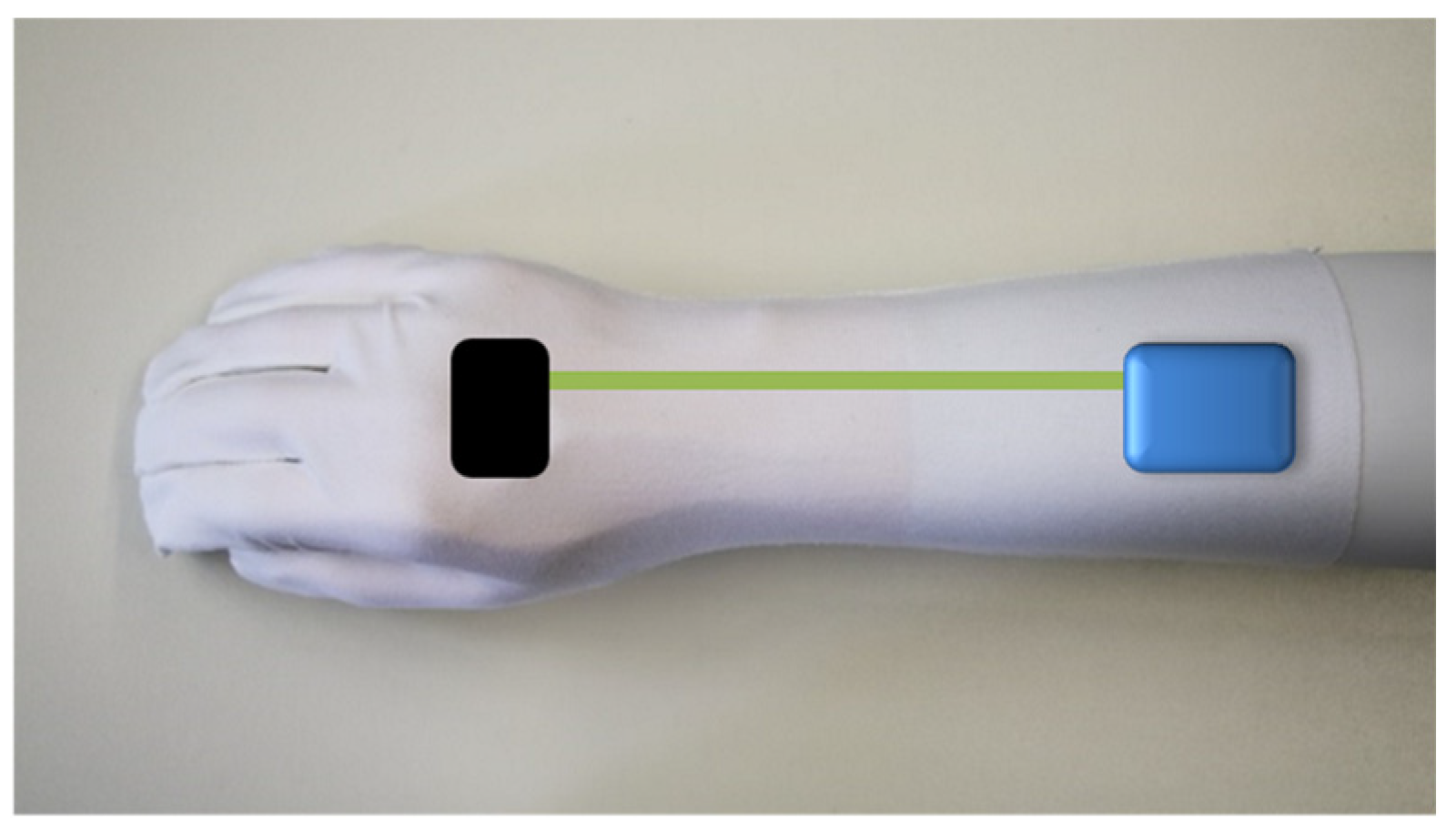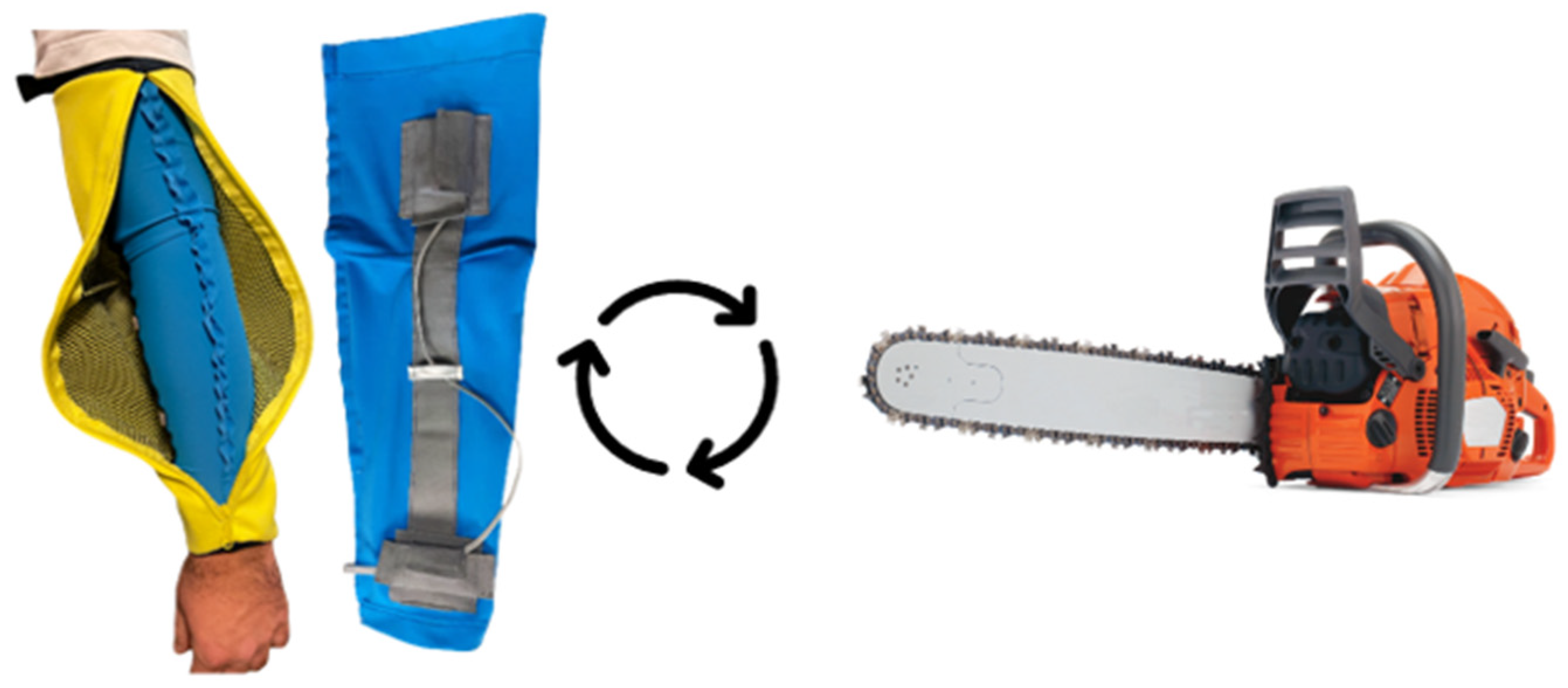Smart Protective Glove for Personal Protective Equipment (PPE) Against Chainsaws for Arborists
Abstract
:1. Introduction
1.1. Accident Situation
1.2. Gloves Used by Arborists
1.3. Current Trends in PPE and Chainsaws for Smart Personal Protective Systems (SPPS) in Forestry
1.4. Aim of the Work
2. Materials and Methods
3. Results
3.1. Regulations and Standards for Protective Clothing Against Chainsaws
3.2. Additional Regulations and Standards Due to the Smart Function in the Glove
3.3. Different Work Situations and the Risks They Present of Getting Injured by the Chainsaw
3.4. Requirements on the Design and Pattern of the Glove Dependent on the Work Situation
3.5. Different Patterns and Designs for the Glove
3.6. Asking Arborists About the Four Glove Models and Their Wearing Behavior of Gloves
3.7. Asking Arborists About the Preferred Position of the Electronics
3.8. Integrating Sensors and Electronics into the Arm Cuff
3.9. Testing the Arm Cuff Under Laboratory Conditions
3.10. Final Arm Cuff
4. Discussion
4.1. Design and Electronics
4.2. Test Area and Number of Tests
4.3. Missing Standards and Test Methods
4.4. User Acceptance
5. Conclusions
Author Contributions
Funding
Institutional Review Board Statement
Informed Consent Statement
Data Availability Statement
Acknowledgments
Conflicts of Interest
References
- Occupational Safety and Health Administration eTool: Logging–Manual Operations–Logger–Chain Saw–Chain Saw Injury Locations|Occupational Safety and Health Administration, Chain Saw Injury Locations. Available online: https://www.osha.gov/etools/logging/manual-operations/logger/chain-saw/saw-injuries (accessed on 8 May 2024).
- Cividino, S.R.S.; Gubiani, R.; Pergher, G.; Dell’Antonia, D.; Maroncelli, E. Accident investigation related to the use of chainsaw. J. Agric. Eng. 2013, 44, 687. [Google Scholar] [CrossRef]
- Internal Documents of Social Insurance for Agriculture, Forestry and Horticulture Accident Statistics in Tree Care and Forestry Work 2018 (Sozialversicherung für Landwirtschaft, Forsten und Gartenbau Unfallstatistiken in der Baumpflege und Waldarbeit 2018).
- EN ISO 11393-4:2019; Protective Clothing for Users of Hand-Held Chainsaws–Part 4: Performance Requirements and Test Methods for Protective Gloves (ISO 11393-4:2018). iTeh Standards: Newark, DE, USA, 2019. Available online: https://standards.iteh.ai/catalog/standards/cen/2ed00dc9-f22a-42ff-a496-8c67b8628d28/en-iso-11393-4-2019 (accessed on 8 May 2024).
- Huber, M.; Hoffmann, S.; Brieger, F.; Hartsch, F.; Jaeger, D.; Sauter, U.H. Vibration and Noise Exposure during Pre-Commercial Thinning Operations: What Are the Ergonomic Benefits of the Latest Generation Professional-Grade Battery-Powered Chainsaws? Forests 2021, 12, 1120. [Google Scholar] [CrossRef]
- Dolez, P.I.; Marsha, S.; McQueen, R.H. Fibers and Textiles for Personal Protective Equipment: Review of Recent Progress and Perspectives on Future Developments. Textiles 2022, 2, 349–381. [Google Scholar] [CrossRef]
- Marchal, P.; Baudoin, J. Proposal for a method for analysing smart personal protective systems. Int. J. Occup. Saf. Ergon. 2022, 28, 1566–1576. [Google Scholar] [CrossRef] [PubMed]
- Thierbach, M. EU_OSHA_discussion_paper_Smart_PPE. 2020. Available online: https://cen.iso.org/livelink/livelink/open/centc248wg31 (accessed on 18 August 2020).
- Beringer, J.; Mahr-Erhardt, A.; Hoffmann, P. C3.3–Senor-based Personal Protective Equipment in forestry work with dangerous machines and equipment (power saws)–IGF No. 16119 N. Proc. Sens. 2013, 2013, 389–390. [Google Scholar] [CrossRef]
- Regulation (EU) 2016/425 of the European Parliament and of the Council–of 9 March 2016–on Personal Protective Equipment and Repealing Council Directive 89/ 686/ EEC. Available online: https://eur-lex.europa.eu/eli/reg/2016/425/oj/eng (accessed on 18 September 2024).
- DIN EN ISO 13688:2022-04; Protective Clothing–General Requirements (ISO 13688:2013 + Amd 1:2021); German Version EN ISO 13688:2013 + A1:2021. DIN: Berlin, Germany, 2022. [CrossRef]
- DIN EN ISO 21420; Protective Gloves–General Requirements and Test Methods (ISO 21420:2020). DIN: Berlin, Germany, 2020. Available online: https://www.en-standard.eu/din-en-iso-21420-protective-gloves-general-requirements-and-test-methods-iso-21420-2020/ (accessed on 25 October 2024).
- DIN EN 388:2019-03; Protective Gloves Against Mechanical Risks, German Version. DIN: Berlin, Germany, 2019. [CrossRef]
- Directive 2014/35/EU of the European Parliament and of the Council of 26 February 2014 on the Harmonisation of the Laws of the Member States Relating to the Making Available on the Market of Electrical Equipment Designed for Use Within Certain Voltage Limits (Recast) Text with EEA Relevance. Off. J. Eur. Union 2014, 96, 372. Available online: http://data.europa.eu/eli/dir/2014/35/oj/eng (accessed on 25 October 2024).
- Directive 2014/30/EU of the European Parliament and of the Council of 26 February 2014 on the Harmonisation of the Laws of the Member States Relating to Electromagnetic Compatibility (Recast) Text with EEA Relevance. Off. J. Eur. Union 2014, 96, 79. Available online: http://data.europa.eu/eli/dir/2014/30/oj/eng (accessed on 25 October 2024).
- Directive 2011/65/EU of the European Parliament and of the Council of 8 June 2011 on the Restriction of the Use of Certain Hazardous Substances in Electrical and Electronic Equipment (Recast) Text with EEA Relevance. Off. J. Eur. Union 2011, 174, 88. Available online: http://data.europa.eu/eli/dir/2011/65/oj/eng (accessed on 25 October 2024).
- Directive–2006/42–EN–Machinery Directive–EUR-Lex. Available online: https://eur-lex.europa.eu/eli/dir/2006/42/oj (accessed on 25 October 2024).
- DGUV Regel 114-018 Waldarbeiten; Deutsche Gesetzliche Unfallversicherung (DGUV): Munich, Germany, 2011; Available online: https://publikationen.dguv.de/widgets/pdf/download/article/1019 (accessed on 16 October 2024).
- DGUV Information 214-046 Sichere Waldarbeiten; Deutsche Gesetzliche Unfallversicherung e.V. (DGUV): Munich, Germany, 2014; Available online: https://publikationen.dguv.de/widgets/pdf/download/article/1263 (accessed on 16 October 2024).
- Buchweiller, J.-P.; Mayer, A.; Klein, R.; Iotti, J.-M.; Kusy, A.; Reinert, D.; Christ, E. Safety of electronic circuits integrated into personal protective equipment (PPE). Saf. Sci. 2003, 41, 395–408. [Google Scholar] [CrossRef]
- Dolez, P.I.; Decaens, J.; Buns, T.; Lachapelle, D.; Vermeersch, O. Applications of smart textiles in occupational health and safety. IOP Conf. Ser. Mater. Sci. Eng. 2020, 827, 012014. [Google Scholar] [CrossRef]







| Passive Protection | Active Protection | |
|---|---|---|
| Dangerous situation | Protects when danger occurs | Protects before danger occurs |
| Activation of the protective function | The chainsaw is already too close to the body. The chainsaw touches the fabric and stops when the fabric is destroyed. | The system is activated when the chainsaw is close to the body. The chainsaw stops before the saw touches the fabric of the PPE. |
| Protection principle | Mechanical protection | Electrical protection |
| Example | Existing textile-based PPE Protection against chainsaws: several layers of cut-protective fabric | Smart personal protective systems (SPPS) Protection against chainsaws: smart protective glove for PPE |
| Wearing comfort | thick -> very warm -> sweating -> mobility restrictions | thin -> less sweating -> higher tactility |
| Standard | Examples Concerning a Smart Protective Glove for Arborists |
|---|---|
| REGULATION (EU) 2016/425 On personal protective equipment [10] |
|
| DIN EN ISO 13688:2022-04 Protective Clothing—General Requirements [11] |
|
| DIN EN ISO 11393-4 Protective Clothing for Users of Hand-Held Chainsaws [4] |
|
| DIN EN ISO 21420 Protective Gloves—General Requirements [12] |
|
| DIN EN 388:2019-03 Protective Gloves Against Mechanical Risks [13] |
|
| Number | Examples Related to the Glove |
|---|---|
| Low Voltage Directive 2014/35/EU |
|
| EMC Directive 2014/30/EU |
|
| Machinery Directive 2006/42/EC |
|
| RoHS Directive 2011/65/EC |
|
| Work Situation | Description | |
|---|---|---|
| Working with ropes and climbing |  | The arborist attaches or detaches the rope or climbs Risk of injuries by the saw: low when the chain brake is engaged or the saw is turned off; sharp chain |
| Sawing |  | The arborist saws in the tree or on a platform Risk of injuries: holding the chainsaw with one hand and cutting into the other hand; getting a kickback into the body; sawing but not seeing body parts and cutting into the body |
| Tidying up |  | The arborist cleans up Risk of injuries: holding the chainsaw with one hand and cutting into the other hand; getting a kickback into the body |
| To Attach Ropes/ to Rope Down | To Climb | To Saw | To Tidy Up | |
|---|---|---|---|---|
| Tactility | High | High | Low | Middle |
| Covered fingers | All fingers must be covered by a glove | All fingers must be covered by a glove | All fingers must be covered by a glove | All fingers must be covered by a glove |
| Fit | Tight | Tight | Tight hem to avoid dirt inside of the glove | Loose or tight fit |
| Fabric | Thin, good grip, robust, resistant to abrasion, moisture and dirt repellent | Thin, good grip, robust, resistant to abrasion, moisture and dirt repellent | Good grip, signal color (left), robust | Robust, moisture and dirt repellent, resistant to abrasion |
| Sensors | Active | Active | Active | Active |
| Influences | Moisture, mud, abrasive surfaces | Moisture, mud, abrasive surfaces, sharp edges | Oil, dust, petrol | Moisture, mud, abrasive surface, sharp edges |
| Electronic Parts | Function of the Electronic Parts |
|---|---|
| Bluetooth low-energy module | Detection of persons, communication with the saw |
| Magnetic field sensor | Detection of the chainsaw |
| IMU (inertial measurement unit) | Detection of kickbacks and movements |
| Battery | Energy source |
| Red and green LEDs | Showing that the system is active and works well (green light) or has a malfunction (red light) |
| Microcontroller | Configuration and control of the peripheral areas |
| Concerns of the User | How the Concerns Can be Reduced |
|---|---|
| Reliability: Users may worry about the reliability of the new technology. |
|
| Cost: Smart PPE can be more expensive than traditional PPE. |
|
| Complexity: Users may find smart PPE complicated to use. |
|
| Comfort: Users may find smart PPE uncomfortable to wear. |
|
| Usability: Users may find smart PPE uncomfortable to use. |
|
| Durability: Users may worry about the durability of the technology, especially in harsh environments. |
|
| Data Privacy and Security: Users may be concerned about how their data are collected, stored, and used. |
|
| Maintenance and Support: Users may be apprehensive about the maintenance required for smart PPE. |
|
Disclaimer/Publisher’s Note: The statements, opinions and data contained in all publications are solely those of the individual author(s) and contributor(s) and not of MDPI and/or the editor(s). MDPI and/or the editor(s) disclaim responsibility for any injury to people or property resulting from any ideas, methods, instructions or products referred to in the content. |
© 2025 by the authors. Licensee MDPI, Basel, Switzerland. This article is an open access article distributed under the terms and conditions of the Creative Commons Attribution (CC BY) license (https://creativecommons.org/licenses/by/4.0/).
Share and Cite
Blocher, S.; Wolff, D.; Fassbender, D.; Schneider, M. Smart Protective Glove for Personal Protective Equipment (PPE) Against Chainsaws for Arborists. Materials 2025, 18, 1010. https://doi.org/10.3390/ma18051010
Blocher S, Wolff D, Fassbender D, Schneider M. Smart Protective Glove for Personal Protective Equipment (PPE) Against Chainsaws for Arborists. Materials. 2025; 18(5):1010. https://doi.org/10.3390/ma18051010
Chicago/Turabian StyleBlocher, Sandra, Dirk Wolff, Dennis Fassbender, and Michael Schneider. 2025. "Smart Protective Glove for Personal Protective Equipment (PPE) Against Chainsaws for Arborists" Materials 18, no. 5: 1010. https://doi.org/10.3390/ma18051010
APA StyleBlocher, S., Wolff, D., Fassbender, D., & Schneider, M. (2025). Smart Protective Glove for Personal Protective Equipment (PPE) Against Chainsaws for Arborists. Materials, 18(5), 1010. https://doi.org/10.3390/ma18051010




